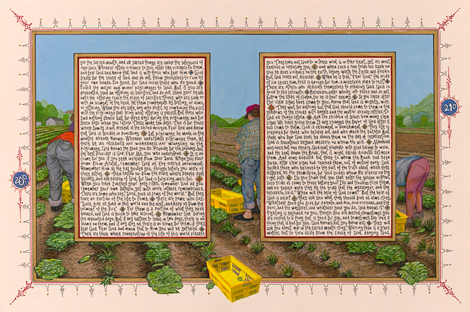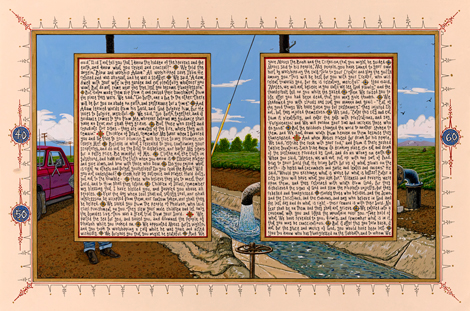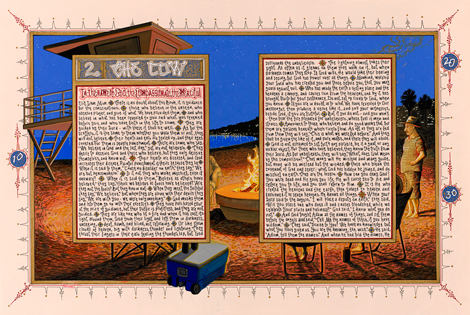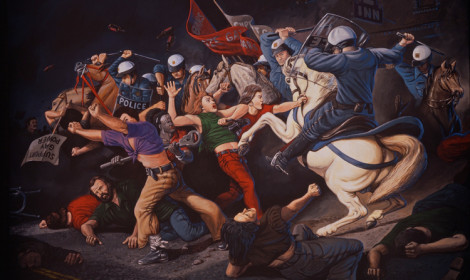Perhaps the best example of the depth and breadth of Sandow Birk’s artistic oeuvre, along with its powerful social/political implications, is his recently completed “American Qur’an,” nine years in the making. Birk conceived of this series during the Iraq and Afghanistan wars, when he was devouring the news each day, often hearing demeaning stories about Islam from politicians and others.
On a sweltering August day, I met Birk in his large Long Beach apartment/studio with its spare modern furnishings. Just back from his morning surf in nearby Huntington Beach dressed in shorts and T-shirt, the fit, handsome 53-year-old eagerly discussed his monumental Qur’an project. He explained that as a world traveler, he had been to many Islamic locales, had met wonderful people there, and was appalled at hearing so many negative reports about Islam, “So I decided to do my Qur’an series,” he said.

Sandow Birk. American Qur’an, Sura 31 A, 2009, Ink and gouache on paper
16 x 24 inches, Private Collection, Image courtesy of Catharine Clark Gallery, Koplin del Rio, and P.P.O.W., Copyright: Sandow Birk
With his characteristic devotion to research, Birk first read the Qur’an several times. He also researched the Islamic world, personally visiting mosques, libraries, art collections and scholars there. “I then transcribed the entire English version of the Qur’an onto 243 double-paged drawings,” he said. He showed me his recently published “American Qur’an” catalog, with all 243 Qur’an drawings, explaining that the book and his upcoming exhibition of this work at the Orange County Museum of Art are not likely to upset Muslins, as some have suggested. “That’s not an approach that looks at the actual artwork or sees the project in a complex way,” Birk emphasized. “The vast majority are not [angry about his work]. And I hope it becomes more evident once the whole project—including its metaphorical images of the U.S. today—is on display.”
When asked about the handwriting he employed transcribing his Islamic “bible,” he explained, “My script is based on graffiti writing, with Islamic shadows. Calligraphy is basic to Islamic artwork, and I thought, who cares more about writing in this country than graffiti artists?” Birk added, “Throughout my career, I’d get a tiny idea in my head and then I’d try to make it into an interesting work.” Yet with the Qur’an and other projects, his “tiny ideas” are nurtured by traveling, observing, dialoging, delving into the darker aspects of life, and depicting these aspects in drawings, paintings, sculptures, woodcuts and lithographs. “American Qu’ran” in fact had a spiritual/artistic predecessor in 2006—Birk’s 15-piece woodcut project, “The Depravities of War,” expressing the horrors of the Iraq War.

Sandow Birk, American Qur’an, Sura 2 H, 2014, Ink and gouache on paper
16 x 24 inches, Image courtesy of Catharine Clark Gallery, Koplin del Rio, and P.P.O.W., Copyright: Sandow Birk
Born in Detroit, Birk moved to Orange County’s Seal Beach at age five. From an early age, he excelled at drawing and surfing; two passions he integrated in high school by painting surfboards. The punk rocker initially planned to go to architecture school, but instead attended Otis College of Art and Design in LA, in part because “students there had Mohawks.” After a few years, he traveled to South America and spent two years in Rio de Janeiro, surfing, painting surfboards and designing a surfing magazine.
He then moved to Europe in 1984, studying at Parsons School of Design in Paris and Bath Academy of Art in England, and spending hours at the Louvre and Tate museums, copying 1800s salon-style paintings. These “Romantic” paintings, emphasizing free expression, emotion and heroism, resonated with Birk’s own aesthetic sensibilities. The crux of his art education, he explains, was primarily self-taught in Paris and England.

Sandow Birk, American Qur’an, Sura 2 B, 2014, Ink and gouache on paper
16 x 24 inches, Image courtesy of Catharine Clark Gallery, Koplin del Rio, and P.P.O.W., Copyright: Sandow Birk
Birk returned to the U.S., completing his BFA at Otis. After graduation in 1988, he moved to an illegal storefront near LA’s Crenshaw District, working as a preparator in galleries and, at night, painting large canvases of people and events in his dicey neighborhood; “the crack deals, the police hassling people, the gang battles, and the graffiti crews. I was paintings spoofs of the romantic French painting from the 1800s, taking drug dealers and gangsters and making them the stars of these grandiose salon paintings,” Birk told me. In the early ’90s, he showed these “Urban Works” in LA’s Zero One Gallery, a freewheeling, quasi-legal storefront at Melrose and La Brea. In March 1992, he had a solo show of these paintings in Santa Monica’s Bess Cutler Gallery, which has since folded. Shortly afterward, the LA Riots broke out, and Birk at the embattled epicenter describes the four-day riot period and its build-up as transformative. “Everyone was looking at LA, and LA was rising up to fight the good fight for justice.” He also began to think about the significance of his works, which depicted and even seemed to predict the volatile word around him. “I was trying to be a real history painter of the events around me, and began documenting the beatings of Rodney King and Reginald Denny and the arrest of O.J. Simpson.”
Birk, whose 1992 “Urban Works” paintings had graced the covers of GQ and Details, was soon creating a new series every few years. Throughout all these series Birk has maintained relevancy to contemporary life, attention to details, expressive rendering, awareness of art history, and respect for artists of the past. His 2000 “In Smog and Thunder, Historical Works from the Great War of the Californias,” is a fanciful series about the mutual disdain between northern and southern California, which the artist often felt while represented by galleries in both parts of the State. It includes paintings, drawings, prints, posters, maps, models and a video documentary; while its salon-type paintings are inspired by 19th-century images.
Birk has won awards including an NEA grant, Guggenheim, Fulbright and Getty fellowships, while creating series addressing the harsh realities of contemporary life, His “Divine Comedy” (2004) warrants special attention for his appropriation of Dante’s ancient tome and updating it with contemporary slang and illustrations. He rewrote the book with Marcus Sanders, and illustrated it with 60 lithographs, this time with medieval characters inhabiting fast food joints, service stations, ATMs and other postmodern settings. Chronicle Books published his Dante’s Inferno in 2006, and he completed a film on the project in 2007.

Sandow Birk, American Qur’an, Sura 2 A, 2014, Ink and gouache on paper
16 x 24 inches, Image courtesy of Catharine Clark Gallery, Koplin del Rio, and P.P.O.W., Copyright: Sandow Birk
After nine years creating “American Qur’an,” exhibiting its pages in nine venues including the Andy Warhol Museum, Birk describes his process designing it in an email: “My page layouts, border designs and use of ‘palmettes’ (small floral designs in the margins and the text, marking the beginning of verses) are taken from the design of Qur’ans spanning a 1000 years. The floral blurbs in the margins, containing numbers marking each 10th verse, are also traditional. The paint is gouache, which was used in historic times, and my style has the isometric, 2D perspective of Persian paintings.”
When asked to compare his Qur’an with R. Crumb’s illustrated The Book of Genesis, Birk reminds me that he began his project five years before Crumb started his bible, explaining, “I don’t actually find his project very interesting. Crumb describes his project as a very literal ‘illustrating’ of the text. But my project is the opposite of his and is based on metaphor. Mine puts the ancient text into contemporary terms, comparing how a message from God might remain relevant in one’s life today.”
When asked if his Qur’an project has incited the ire of Muslims, Birk waxes philosophical: “My project, which does not depict Muhammad [as the original Qur’an does] is done out of a sincere effort to learn and understand. One’s amazement that Muslims are not outraged by this project presupposes that they are quick to anger and cannot be thoughtful, interesting, intelligent, art-appreciating people. But the Islamic community has been overwhelmingly positive, especially the younger generation. At first, the project raised eyebrows from a few people, but once they saw it, they supported it. The only negative criticism came in emails [to Koplin del Rio Gallery in LA] when I first showed it. Right-wing Christian groups thought that Americans shouldn’t be reading the Qur’an, and said that the show should be taken down.”
Sandow Birk’s entire “American Qu’ran” will be exhibited at Orange County Museum of Art, Newport Beach, through February 28.




